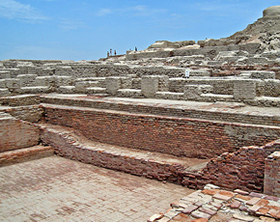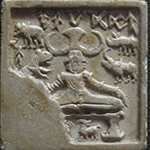Origins of Hinduism
Indus Valley CivilisationRead about key features1 of the Indus Valley civilisation. Examine the geographical setting2 and natural features of the Indus Valley and how the environment3 influenced the civilisation. Study the excavations4 at the ancient city of Mohenjodaro. Examine the many terracotta figurines5 from Harappa and read how they have been interpreted. Take the Indus Challenge on types of pottery.6
Photo by GR Jatoi 7 CC BY-ND 3.08 |
Harappa and MohenjodaroExamine Harappa in 3-D9 based on excavations at the site. Take a virtual tour10 of Mohenjodaro, one of the largest Bronze Age cities in the world. Examine images of important sites in Mohenjodaro (‘Mound of the Dead’). Read pages in an archaeologist’s notebook13 about objects found at Mohenjodaro. Study the trade products14 exchanged between inhabitants in the valley and the highland. Learn about the Indus Valley’s agricultural base15. Examine the beliefs, values and practices of the Harappan civilisation. Read about how the Indus Valley civilisation declined16, including the decline of writing. |
The Aryans and the Vedic periodA wave of Indo-Aryan migration17 followed the decline of the Indus Valley civilisation. Explore the cultural change18s that resulted from Indo-Aryan migration. The oral tradition of the semi-nomadic Aryans told stories of intertribal warfare and migrations. Read about the Vedic period19. Find out how the varnas20 become the rigid social structure of the caste system in Vedic India.
Photo by Kenny OMG21 CC BY-SA 3.022 Examine the beliefs, values and practices of the Aryans during the Vedic period. Read about the Vedas23, one of the sacred texts of Hinduism. Explore scripts24 used in ancient India—Indus, Brahmi and Kharosthi. |
Links
- https://en.wikipedia.org/wiki/Indus_Valley_Civilisation
- http://www.ancientindia.co.uk/geography/explore/exp_set.html
- http://www.harappa.com/indus/indus6.html
- http://science.nationalgeographic.com/science/archaeology/mohenjo-daro/
- http://www.harappa.com/figurines/index.html
- http://www.ancientindia.co.uk/indus/challenge/cha_set.html
- http://www.panoramio.com/user/3589361?comment_page=1&photo_page=3
- http://creativecommons.org/licenses/by-nd/3.0/
- https://www.google.com/culturalinstitute/u/0/asset-viewer/harappa-museum-sahiwal/TwE1lD1fKIPhSg?projectId=wonders-of-pakistan
- http://virtualglobetrotting.com/map/mohenjo-daro/view/?service=0
- http://commons.wikimedia.org/wiki/File:Yogi._Mold_of_Seal,_Indus_valley_civilization.jpg
- http://creativecommons.org/publicdomain/zero/1.0/deed.en
- http://www.ancientindia.co.uk/indus/explore/n_index.html
- http://www.harappa.com/indus/indus8.html
- http://www.newworldencyclopedia.org/entry/Indus_Valley_Civilization#Agriculture
- http://www.mohenjodaro.net/indusdecline.html
- http://en.wikipedia.org/wiki/Indo-Aryan_migration
- http://www.harappa.com/script/maha2.html
- http://www.bbc.co.uk/religion/religions/hinduism/history/history_1.shtml#h3
- https://en.wikipedia.org/wiki/Varna_(Hinduism)
- http://commons.wikimedia.org/wiki/File:Indus_Valley_near_Leh.jpg
- http://creativecommons.org/licenses/by-sa/3.0/deed.en
- https://en.wikipedia.org/wiki/Vedas
- http://www.ancientindia.co.uk/writing/explore/exp_set.html




